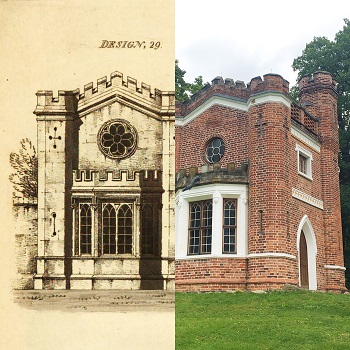Academic thesis
| Christoph Oschatz: | The use of English and German pattern books at the Garden Kingdom of Dessau-Wörlitz at the turn of the 19th century | back |
| Language: | Original - Translation | |
| Overview: |
|
|
 Title Page
|
|
| Abstract: | This master-dissertation investigates the use of pattern books of British and German origin in the design of three late 18th century case studies at the landscape gardens of Wörlitz and Luisium within the Garden Kingdom of Dessau Wörlitz in Germany. This UNESCO World Heritage Site was highly influential to the development of landscape gardens, neoclassical and ne-gothic architecture, education and agriculture in Germany and continental Europe. The case studies chosen are smaller buildings and structures within the setting of landscape gardens and their relationship to their respective pattern book origins were at the start of this research under-explored. The author argues that the story of their conception can be used to illustrate and draw conclusions on the wider German and British context of architectural design and cultural transfer of architectural ideas at the time and ultimately warrants a re-evaluation of their significance. The main methods employed for this research was a literature review on the subjects of pattern books, architectural publications in Germany and Britain and cultural transfer between the two countries at the turn of the 18th century. Additionally, British and German pattern books of the time were compared and evaluated. This was complemented by personal communication with experts in the field and site visits. The research found that each case study illustrates a differing aspect of an intricate process of replication, translation and adaptation of designs and their built counterparts. Additional stages within this process, such as the copying of content in German publications from earlier British authors without reference offer thought-provoking insights into copyright and authorship issues. Finally, case study 2 – the so called ‘Schlangenhaus’ or ‘snake house’ at Luisium Landscape garden - opens up the prospect that its built form could have informed a British pattern book design, a possibility that would reverse the predominant direction of cultural and architectural transfer between the countries. It is one of the further research recommendations that the construction date of this case study needs to be re-examined. However, the author also demonstrates that the necessary actors, personal and commercial relationships between Dessau-Wörlitz, Germany and Britain existed which would have been able to provide the necessary ‘means, motive, and opportunity’ for the Schlangenhaus to act as a precedent for a British pattern book – a fascinating prospect. The author concludes that the significance of all three case studies is tied to how intimately they were embedded in the architectural discourse of 18th century Europe and how this discourse was carried out in the use of pattern books. |
| Keywords: | pattern books, 18th century, architecture, landscape gardens, Dessau-Wörlitz, Wörlitz, England, Germany, architectural design, neo-classicism, neo-gothic, architectural publications, Europe, cultural transfer, James Malton, garden buildings and structures, Europe, Leopold III. Friedrich Franz, Anhalt-Dessau, Luisium |
| Table of contents: | 1. Introduction 8 1.1 Context 8 1.2 Research question 9 1.3 Aims and objectives 9 1.4 Rationale 10 1.5 Methodology 11 1.5.1 Structure 11 1.5.2 Research sources 12 1.6 Limitations 13 2. The making of Dessau-Wörlitz 14 2.1 Creating the Dessau-Wörlitz Garden Kingdom 14 2.2 Inspired Wörlitz 16 3. Three Dessau-Wörlitz case studies and their pattern book counterparts 18 3.1 The garden inspector’s house at Wörlitz 18 3.1.1 Building 18 3.1.2 Pattern book references 19 3.1.3 Relationship between pattern books and building 22 3.2 The Schlangenhaus at Luisium landscape garden 23 3.2.1 Building 23 3.2.2 Pattern book reference 24 3.2.3 Relationship between pattern book and building 26 3.2.4 A note on the construction date of the building 27 3.3 The gatehouses at Luisium landscape garden 29 3.3.1 Building 29 3.3.2 Pattern book reference 29 3.3.3 Relationship between pattern book and building 30 4. Pattern books and the architectural debate at the end of the 18th century 31 4.1 Introduction 31 4.2 The architectural debate at the end of the 18th century 31 4.2.1 Neo-Gothic vs Neo-classicism 31 4.2.2 Symmetry 33 4.2.3 Utility 34 4.3 Designers, authorship and copyright 35 4.4 Domestic architectural publications 37 4.5 Pattern books in Britain and Germany 39 4.6 Pattern books and built structures 41 4.7 The pattern books related to the case studies 42 5. The Garden inspector’s house: Inspiration Made in Britain 45 5.1 Introduction 45 5.2 Dissemination and assimilation of British architectural trends and precedents in Germany 45 5.2.1 British publications in Germany 46 5.2.2 British and European precedents utilised in German publications 46 5.3 German publications on rural architecture and cottages 48 5.4 Duke Leopold III’s library at Wörlitz 50 5.5 What does the choice for the design of the garden inspector’s house in Wörlitz indicate? 52 6. The Schlangenhaus: Could Malton have copied its design from the Luisium? 53 6.1 Introduction 53 6.2 From within Dessau-Wörlitz 53 6.2.1 Die Chalkographische Gesellschaft 53 6.2.2 Die Allgemeine Buchhandlung 54 6.2.3 Publicising the Luisium 54 6.3 Influence within Germany 56 6.3.1 Hirschfeld’s ‚Theorie der Gartenkunst‘ 1779-1785 56 6.3.2 Johann Gottfried Grohmann 56 6.3.3 Christian Ludwig Stieglitz 57 6.3.4 Wilhelm Gottlieb Becker 58 6.3.5 Charles Joseph de Ligne 58 6.4 German - British cultural transfer 58 6.4.1 German – British cultural transfer in the second half of the 18th century 58 6.4.2 German printing, publishing and bookselling in Britain at the end of the 18th century 59 6.5 James Malton – architectural draughtsman, designer and businessman 62 7. Conclusions 64 7.1 Recommendations for further research 66 References 67 Appendix 1 – Chronological outline 72 |
| Details: |
|
| Download: |
full-text thesis (pdf-data format, approx. 6.5 MB) |
| DOI (Digital Object Identifier) | 10.5165/hawk-hhg/416 |
The Hornemann Institute offers only the information displayed here. For further information or copies of academic work, please contact the author or - if there is no contact provided - the secretariats of the respective faculties.